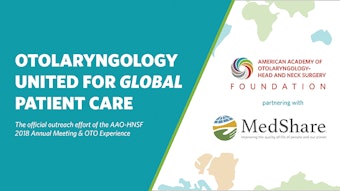Reg-ent℠: MIPS 2018 reporting FAQs
How will the Reg-ent registry help my practice with MIPS 2018 reporting?
Reg-ent has numerous benefits for AAO-HNS members and is the MIPS 2018 reporting tool of choice for otolaryngologists because:
- Reg-ent provides access to more otolaryngology-specific quality measures than any other available MIPS reporting mechanism. Reg-ent contains 18 otolaryngology-specific Qualified Clinical Data Registry (QCDR) measures that are exclusive to the registry. In addition to these 18 QCDR measures developed by AAO-HNSF, Reg-ent also contains 37 publicly available quality measures that include otolaryngology-specific measures, as well as measures to meet the overall needs of the specialty.
- Reg-ent is first and foremost an otolaryngology clinical data registry, and by participating in Reg-ent, you are contributing to the growth of the national data repository. Reg-ent:
- Allows members to define quality otolaryngology care and make improvements in the care and outcomes of their patients.
- Is an investment in the future of otolaryngology-head and neck surgery.
- Safeguards the role of otolaryngologist-head and neck surgeons in defining the best care.
- Helps define and develop otolaryngology-specific quality measures.
- Provides access to future private payer quality programs, fulfillment of maintenance of certification requirements, and FDA product surveillance.
How will the Reg-ent registry help my practice with MIPS 2018 reporting?
As a QCDR, Reg-ent can accommodate reporting for all required MIPS 2018 performance categories, including Quality, Promoting Interoperability (PI), formerly known as Advancing Care Information (ACI), and Improvement Activities (IA). Reg-ent staff at AAO-HNSF and FIGmd (the registry’s technical vendor partner) will work closely with your practice through the process of quality measures mapping and measures selection, PI, and IA data entry and attestations, and ultimately the submission to CMS.
What are the new requirements and changes for MIPS 2018 reporting?
CMS has outlined the new requirements for MIPS 2018 reporting in the Quality Payment Program (QPP) Year 2 Final Rule:
- The low volume threshold has increased. For 2018, providers who have less than or equal to $90,000 in Medicare-allowed charges or provide care to 200 or fewer Medicare beneficiaries will be excluded from MIPS
- 2018 reporting. Use the CMS 2018 MIPS
- Eligibility Lookup Tool at https://qpp.cms.gov/participation-lookup/ to determine your eligibility.
- Virtual Groups, defined as solo practitioners and groups of 10 or fewer Eligible Clinicians (ECs) who come together virtually to participate in MIPS for a performance year, have been added as a new way to participate in MIPS 2018 reporting. Reg-ent is able to accommodate Virtual Group reporting.
*Note: To report as a Virtual Group for the 2018 Performance Year, the election process had to be completed by December 31, 2017. - There are new bonus points for small practices and for treatment of complex patients.
- You are now required to submit Quality category data for the full year while PI and IA categories have a minimum performance period of 90 days. Cost data, as calculated by CMS utilizing administrative claims, are required for the full year.
- The Quality Performance category will now be 50 percent of your final score (compared to 60 percent in 2017). As in 2017, you are required to report on six quality measures, with one of the six being an Outcome measure (or a High-Priority measure if an Outcome measure is not available).
- The Cost category will count toward 10 percent of your final score and will be calculated by CMS through administrative claims data—no additional submission is required for the Cost category.
- For the PI category, a 10 percent bonus will be given to those who use only 2015 edition CEHRT.
- Small practices (15 or fewer clinicians) can apply for a PI Hardship Exception—please note that if accepted, the PI category will be reweighted to zero and the Quality category will be increased to 75 percent of your final score.
- To learn more about the details of these changes, view our Reg-ent MIPS 2018 resources at http://www.entnet.org/content/reg-ent%E2%84%A0-mips-2018-measures. If you have questions specifically related to the MIPS 2018 reporting requirements, contact the Academy’s Health Policy team at healthpolicy@entnet.org.
Are there otolaryngology-specific quality measures available through Reg-ent?
Yes. For MIPS 2018 reporting, there are 18 otolaryngology-specific QCDR measures available exclusively through Reg-ent. The topics for these QCDR measures include otitis media with effusion, cerumen impaction, allergic rhinitis, age-related hearing loss, Bell’s Palsy, and tympanostomy tubes. In addition to the QCDR measures, Reg-ent has 37 publicly available QPP measures available for MIPS 2018 reporting, bringing the total quality measures in Reg-ent to 55. To view more details about these measures, visit www.entnet.org/2018-measures.
How is PI and IA reporting done through Reg-ent?
Reporting for the PI and IA categories is done through data entry and attestations in the Reg-ent MIPS dashboard. Through Reg-ent you can report on either set of PI measure sets (as dependent on your certified electronic health record technology (CEHRT) edition—2014 and/or 2015). For certain PI measures, participants will be required to enter numerator and denominator information; for other PI measures, only attestation is required. Reg-ent includes all the 112 Activities available from CMS for 2018. Of these 112 Activities, Reg-ent provides a list of selected Registry Recommended activities that are most applicable to our participants.
Will I be able to secure any bonus points for using Reg-ent to report MIPS 2018?
Yes. By reporting through Reg-ent, you will be able to secure the bonus points available under MIPS 2018 for end-to-end electronic quality measure reporting, as well as those available under the PI category for attesting to completion of certain Activities using CEHRT. In addition, under the PI category you will earn 10 percent for reporting Quality measures data to Reg-ent.
Will I be able to track my performance and scores for the MIPS reporting categories?
Yes. Reg-ent participants will be able to view and track their scores in each reporting category within the Reg-ent MIPS dashboard. The Reg-ent dashboard provides a visual representation of your data and allows you to benchmark your performance at the practice, location, and provider levels against your peers in Reg-ent.
All final payment adjustments are determined by CMS and will be applied in 2020 for the 2018 reporting year.
By what date must I join Reg-ent to report MIPS 2018?
All practices must have contracts executed by July 16, 2018, to report MIPS 2018 via the EHR integrated method of reporting through the Reg-ent registry.
Will Reg-ent work with my EHR?
Reg-ent is able to work with a wide variety of EHRs. Visit Reg-ent’s EHR vendor resource page at www.entnet.org/content/regent-compatible-emrs-and-practice-management-systems for a complete list of EHR vendors currently connected to Reg-ent.
Direct extraction of data from the practice EHR is the most seamless means by which to submit data to the Reg-ent registry.
*Note: If your EHR data is in the cloud or if you practice in a health system or academic medical center, the Reg-ent registry will work with both the practice and the EHR vendor to push your practice data to the Reg-ent registry. Pushing data requires active engagement from both the practice and vendor, and fees may be charged by your EHR vendor.
I use paper charts in my practice. Will Reg-ent be able to help me report MIPS 2018?
Yes. For practices without EHR systems, Reg-ent offers a web entry tool for reporting MIPS 2018. The web entry tool requires manual entry of your patient and practice data for the quality measures you select. There is also a CSV file upload feature that allows for faster bulk data entry.
Please note that without an EHR you will not be able to report the PI category, which requires the use of a 2014 or 2015 certified EHR. However, you will still be able to report the Quality and IA categories via Reg-ent.
*Note: While the deadline to have a contract executed with Reg-ent in order to use the web entry tool is December 31, 2018, we encourage you to join as early as possible to allow time to enter your quality data. This is especially important now that twelve months of data is required.
When will Reg-ent submit data to CMS?
Submission of data to CMS will begin upon conclusion of the 2018 performance year. While the CMS submission period effectively closes on March 31, 2019, Reg-ent intends to complete all submissions to CMS by mid-February.
What fees does Reg-ent charge?
Participation in Reg-ent is an investment in the single largest quality improvement initiative in AAO-HNSF history.
Reg-ent fees include a one-time application fee of $250 per provider and a $295 yearly subscription fee per provider. Reg-ent fees are not directly tied to MIPS reporting and are required for all participants regardless of reporting needs. By joining Reg-ent you will have access to your registry dashboard and benchmarking data, as well as additional product benefits as they are developed. Reg-ent has moved to an annual January payment and billing cycle for the yearly subscription fee. For the initial subscription fee, the amount your practice pays per provider will be based on the month of registration.
Please see the table on our Reg-ent fees web page at www.entnet.org/content/reg-ent-fees for more information.
How do I get started?
Visit the Reg-ent Sign Up Portal at https://regent.entnet.org/Signup/registry.aspx. To sign up today, make sure you have the following information available:
- list of clinicians that includes the AAO-HNS member IDs and National Provider Identifier (NPI) numbers for each
- individual email address for each provider
- practice Tax Identification Number (TIN)
- practice location address(es)
- credit card or check details
Who may I reach out to if I have additional questions?
Please contact the Reg-ent team at Reg-ent@entnet.org or call 703-836-4444.















